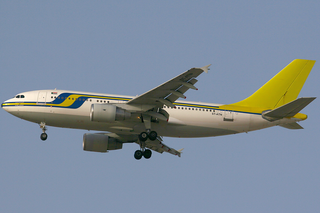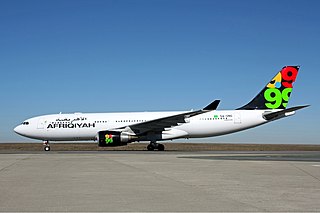A search for the flight's black boxes was immediately conducted. The search was initially hampered due to the ground conditions at the crash site. Both the flight data recorder (FDR) and the cockpit voice recorder (CVR) were eventually found by the search and rescue team, and were taken from the crash site for further investigation. [22] Both recorders were sent to the National Transportation Safety Board (NTSB) in the United States for readout analysis. [6] : 8 Pieces of the wreckage were recovered and were taken off site for further inspection by Thai investigators. Airbus, the aircraft manufacturer, announced that they would send a team of specialists to assist Thai authorities in the crash investigation. [6]
Landing difficulty
In the initial aftermath of the accident, many believed that the weather played a major factor in the disaster. A heavy rainstorm caused by Tropical Storm Gil was reportedly present prior to Flight 261's landing. Several survivors and victims relatives questioned the pilots decision to land at the airport even though the weather was not in acceptable condition for landing. Airline officials had told crew members to fly according to the company's procedures, in which pilots should not land if the meteorological condition in the area was inclement. Investigators stated that bad weather was the probable cause of the accident, without ruling out pilot error. Other possible causes were also being investigated. [24] [9]
According to the available weather data, at the time of the accident the wind was blowing at 3 knots (5.6 km/h; 3.5 mph) with a visibility of 1,000 metres (3,300 ft) with rain reportedly present. [6]
Reports also emerged that the runway at Surat Thani Airport was lacking an essential navigation system. Airport officials only commented that the radio navigation system was working normally and declined to comment further on the issue. Thai officials confirmed that a part of the navigation system, called the Instrument landing system (ILS), had to be taken off-line due to an expansion program at the airport. The system was scheduled to be put back on-line, however the subsequent 1997 Asian financial crisis caused it to be postponed. A Thai air force pilot stated that due to the removal of the Instrument landing system (ILS), pilots had to use a radio navigation system which was less accurate. [25] [24]
The investigation further revealed that the airport's non-directional beacon (NDB) had also been turned off. [6]
At the time of the accident, several lights at the runway end were unlit as the lights were turned off due to a renovation at the airport. This caused the distance between the lights to change at a distance of 6 metres (20 ft) between each other rather than the usual 3 metres (10 ft). The approach lights were also not turned on. The inclement weather condition and the unlit condition of the runway would make it harder for the pilots to see the runway and to land at the airport. [6]
Factors leading to stall
In all of the flight crew's attempts to approach Surat Thani, the pilots always saw the runway at their right side rather than at the front side. This was caused by the placement of the VOR (used as an approach aid by the airport), which was located at the left side of the runway rather than at the middle of the runway (at track 225 degree). In Flight 261, the pilots were on track 215 degree with a visibility of less than 2,000 metres (6,600 ft). As such, the pilots were able to see the runway only if they had passed the runway centreline. In all of their attempts to land, they were too far left of the runway. It was a difficult approach for the pilots and this might have explained why the flight had gone through multiple go-around attempts. Additionally, the pilots were not familiar with non-precision approach. [6]
During the first attempt, the wind was calm and the visibility was 1,500 metres (4,900 ft). The co-pilot sighted the runway and the pilot tried to land at the runway. However, the pilot announced that they were unable to land and decided to go-around. As they initiated the go-around, the pilot noticed the high rate of climb of the aircraft. The co-pilot stated that it might have been caused by the light weight of the aircraft (Flight 261 was 102 tonnes while its permissible landing weight was 122 tonnes). The engines gradually increased and there was a low pitching up moment. Investigators noted that no signs of pilot fatigue were found in the first go-around attempt. [6]
In the second attempt, the pilots decided to use the autopilot. The pilots tried to see the runway. This time, they were unable to see the runway. The unlit condition of several lights at the airport had caused confusion on the pilots. The pilots then decided to go-around with the autopilot and the autothrottle. [6]
In the third attempt, the controller in Surat Thani informed the flight crew that the visibility had deteriorated to 1,000 meters. Both pilots began to worry on the matter. The co-pilot then reported "final approach fix" and the controller cleared Flight 261 to land. The pilots then disengaged the autopilot. [6]
The flight crew of Flight 261 had attempted to land at the airport for at least 2 times. At the time of the accident, the flight crew were attempting their third attempt. If they failed all three attempts, then the flight would have to return to the departure airport (Bangkok), even though they had arrived at the destination airport. The low visibility, the difficult landing attempt in Surat Thani, and the possibility of going back to Bangkok caused a heavy workload on the pilots of Flight 261. The flight crew's attention was channelized due to the stress, causing them to work in not optimal condition. It would also endanger their situational awareness. [6]
The aircraft involved in the accident was an Airbus A310, a medium range airliner equipped with 2 large turbo fan engines, both of which were located under swept back wings. According to investigators, if the pilots decided to trigger the go lever during go-around mode, the autothrottle system would move the throttle forward at a rate of 8 degree per second. This would cause the aircraft's nose to pitch up. If the pilots decided to use the autopilot, the pitch attitude would be regulated by the system. However, if the pilots decided to use manual control and the pilots were not aware with their surrounding, there would be a chance in that the pilots would lose control of the aircraft's pitch, causing the aircraft to enter an upset. [6]
As the pilots began their third attempt, the pilots were manually flying the aircraft. They were unable to see the runway until they were too close. The flight crew then declared "cannot land, cannot land" and decided to go-around. The pilots then decided to trigger the go lever (autothrottle). The engines then spun from 59% to 102% in a span of 8 seconds. The aircraft quickly pitched up, which was described by a surviving flight attendants as "the pilots pulling up the aircraft harshly". [6]
The pilots felt familiar with the nose up moment that had happened in their first and second go around. Thus, they didn't consider the possibility that the aircraft would ever enter an upset condition in the third attempt. The pitch continued to increase and the pilots tried to level the pitch with the aircraft's elevator. It managed to decrease the pitch rate for a small amount. However, it then started to increase again, reaching as high as 40 degree. The pilots, again, applied the elevator to decrease the pitch. The pitch was decreased to 32-33 degree for approximately 6 seconds. The pilots then suddenly did not apply the elevator anymore, causing the pitch to increase to 47-48 degree. By this time, the speed had decayed to 100 knots (185 km/h; 115 mph). The aircraft then entered a stall and crashed onto the swamp. [6]













